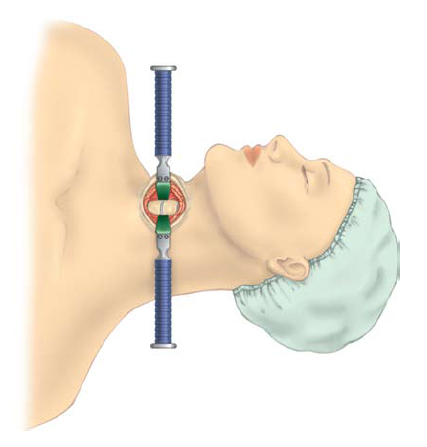Anterior Cervical Discectomy and Fusion (ACDF) is a surgery to remove degenerated discs and bone spurs in the neck of the spine. The incision is made in the front of the neck through a skin crease for cosmesis. The dissection is carried out between the trachea, esophagus and neck muscles. Once the disc is removed and the spinal cord nerves are decompressed a bone graft is inserted into the empty space. The bone graft contains cells that help stimulate bony growth across the disc space. Utilizing minimally invasive techniques, bone screws incorporated into the graft are used to anchor the graft in place. The body begins the healing process by laying down new bony growth to fuse the two segments together. The procedure takes approximately 1-2 hours per level and patients are typically monitored in the hospital overnight. After the procedure, pain improves quickly, and symptoms of spinal cord dysfunction such as weakness, instability and loss of motor coordination may improve depending on the degree of nerve damage. Post-operatively, patients require the use of a brace and bone stimulator to aid in healing.
Anterior cervical discectomy with fusion is a surgical procedure that involves relieving the pressure placed on nerve roots and/or the spinal cord by a herniated disc or bone spurs in the neck – a condition referred to as nerve root compression.

Cervical refers to the 7 vertebrae of the neck. Discs are the spongy, cartilaginous pads between each vertebra, and ectomy means “to take out”. In a cervical discectomy, the surgeon accesses the cervical spine through a small incision in the neck and removes all or part of the disc – and/or in some cases bone material – that’s pressing on the nerves and causing pain.
Spinal fusion involves placing bone graft between two or more affected vertebrae to promote bone growth between the vertebral bodies. The graft material acts as a binding medium and also helps maintain normal disc height – as the body heals, the vertebral bone and bone graft eventually grow together to join the vertebrae and stabilize the spine.
If you have a herniated disc, this means that the nucleus pulposus – the soft, gel-like center of the disc – has pushed through the annulus fibrosus, the disc’s tough, outer ring. Bone spurs, also called osteophytes, can form when the joints of the spine calcify.
Pressure placed on the spinal cord as it passes through the cervical spine can be serious, since most of the nerves for rest of the body (e.g., arms, chest, abdomen, legs) must pass through the neck from the brain. A cervical discectomy can ease pressure on the nerves, ultimately providing pain relief.
An anterior cervical discectomy with spinal fusion is typically recommended only after non-surgical treatment methods fail. Your surgeon will take a number of factors into consideration before making this recommendation, including the condition to be treated, your age, health and lifestyle and your anticipated level of activity following surgery. Please discuss this treatment option thoroughly with your spinal care provider.


Dr. Ram R. Vasudevan, MD, FAANS
Austin NeuroSpine PLLC
5300 Bee Cave Road, Building 1,
Suite 220 Austin, TX 78746
Phone: (512) 640-0010
Monday: 8:00 AM – 5:00 PM
Tuesday: 8:00 AM – 5:00 PM
Wednesday: 8:00 AM – 5:00 PM
Thursday: 8:00 AM – 5:00 PM
Friday: 8:00 AM – 5:00 PM
Saturday: Closed
Sunday: Closed
© 2023 Austin NeuroSpine PLLC. All rights reserved.